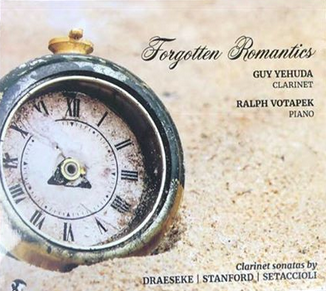News
Guy Yehuda and Ralph Votapek pay homage to forgotten composers
 Forgotten Romantics sheds light on seldom performed works for clarient.
Forgotten Romantics sheds light on seldom performed works for clarient.
When it comes to repertoire from the Romantic period for clarinet and piano, one will most refer to works by Brahms (1894), Saint-Saens (1921), or Schumann (1849), among others. Many other composers from this time period wrote fine works for the clarinet-piano duo, but for various reasons, as illustrated below, were not as favored by time. Brahms’s sonatas have served as the model for many who came after him, and were indeed the main source of inspiration for one of the three following composers in their endeavor to write sonatas for clarinet and piano. This collection of recordings represents a revival of three “Forgotten Romantics” that are arguably worth remembering, and who each offered their own individual and impressive mark on the genre.
The first of these, and the only one to pre-date Brahms, was Felix August Bernhard Draeseke (1835-1913), born in Coburg, Germany, was a composer of the "New German School," prolific in his compositions spanning most genres, including eight operas, four symphonies, six symphonic poems, preludes, overtures, three concerti, three string quartets, and a long list of other orchestral, chamber, choral, vocal and solo piano works.
Draeseke composed his first work at the age of eight, and would eventually go on to study at the Leipzig Conservatory. At the age of 18, he was diagnosed with an ear infection that would eventually lead to an almost complete loss of hearing.
Draeseke’s Sonata in B flat Major for Clarinet and Piano, Op. 38 was written at a highpoint of the composer's career. This work is a Romantic display of virtuosity and beauty, and it is unfortunate that this work is rarely played. Draeseke completed his clarinet sonata on May 22, 1887, and dedicated it to his colleague at the Dresden Conservatory, Friedrich Demnitz, principal clarinetist in the Dresden Hofkapelle. He later composed an alternate version of this same work for violin. In 1887, sonatas by composers like Brahms, Saint-Seans, Reger, and other prominent composers had not yet been written. For this reason, and due to its contribution to the clarinetist’s repertoire of music for clarinet and piano, Draeseke's Sonata, a sophisticated compositional whirlwind; at once pastoral, rhapsodic, wistful, and triumphant, could well be considered the first major clarinet sonata of the 19th century.
Sir Charles Villiers Stanford (1852-1924) was born in Dublin to an Irish Protestant family. Like Draeseke, Stanford also studied in Leipzig, with Carl Reinecke, before moving to Berlin to study with Friedrich Kiel. The time he spent studying in Germany would prove to be an important influence on his career. In 1887 (three years after Draeseke’s appointment in Dresden), Stanford was appointed Professor of Music at Cambridge, while also holding the position of Professor of Composition at the Royal College of Music in London.
Similar to Draeseke’s, Stanford’s Clarinet Sonata, Op. 129, was written during a high point in Stanford’s popularity. The work was completed in 1911 and is dedicated to the clarinetists Oscar Street and Charles Draper, a pupil of Henry Lazarus. Draper had been the soloist in Stanford's Clarinet Concerto in 1903 and gave the first performance of the sonata in 1916 with another former student of Stanford’s, Thomas Dunhill (who also contributed a substantial work to the clarinet’s repertoire of clarinet and piano works, Phantasy Suite Opus 91).
Stanford’s Sonata for Clarinet and Piano Op.129 is arguably one of the finest pieces in the English Romantic repertoire. Written in the spirit of Brahms, the work, alternating between tempestuous and reflective, has one of the most heart-wrenching second movements one is likely to hear in any work from this period. The sonata, like that of Brahms, starts with a sonata-form movement filled with traditional Romantic treatment of melody, notable for the equal interplay between piano and clarinet. The second movement is titled Caoine (Keen), an Irish lament marked Adagio (quasi Fantasia), and demonstrates Stanford’s affinity for Irish Folk tune through occasional reference to Irish harp in the arpeggiated chords of the piano. Brahms’ influence returns in the final Allegretto grazioso, with a declamatory opening and a secondary theme in the lower register of the clarinet, and throughout is still evident in the treatment of the clarinet and piano parts as equals.
Shortly after writing the Clarinet Sonata, Stanford’s popularity began to diminish, as musical tastes evolved and his music and style began to lose relevance. He died in March 1924 at the age of 71 in London, England.
Giacomo Setaccioli (1868-1925) vocal and instrumental composer and conductor, was born in Tarquinia, Italy, and died in Siena at the age of 57. He served as a lecturer at the Accademia di Santa Cecilia, and eventually was appointed Director of the Florence Conservatory. Opera and vocal works historically reigned over Italy’s musical landscape, while composition of instrumental music was less prominent. Several composers, including Setaccioli, contributed to redefining this balance through their compositions for purely instrumental music. Much of Setaccioli’s music has been lost over time, possibly contributing to the lack of information we have of him today, but one of the few pieces that still remains of his operatic and chamber works is, thankfully, his Clarinet Sonata.
Setaccioli’s Clarinet Sonata, Op. 31 (1921), combines lush Romantic harmonies with beautiful, soaring lines rendering this one of the most compelling pieces of chamber music from the beginning of the twentieth century. The work is a combination of traditional treatment of melody and form with a more complex approach to harmony and rhythm. With movements titled “Afternoon,” “Nocturne,” and “Dawn,” and an epigraph, consisting of the third and fourth stanzas from “Sole e Amore” or “Sunlight and love,” we are given hints of programmatic yearning.



